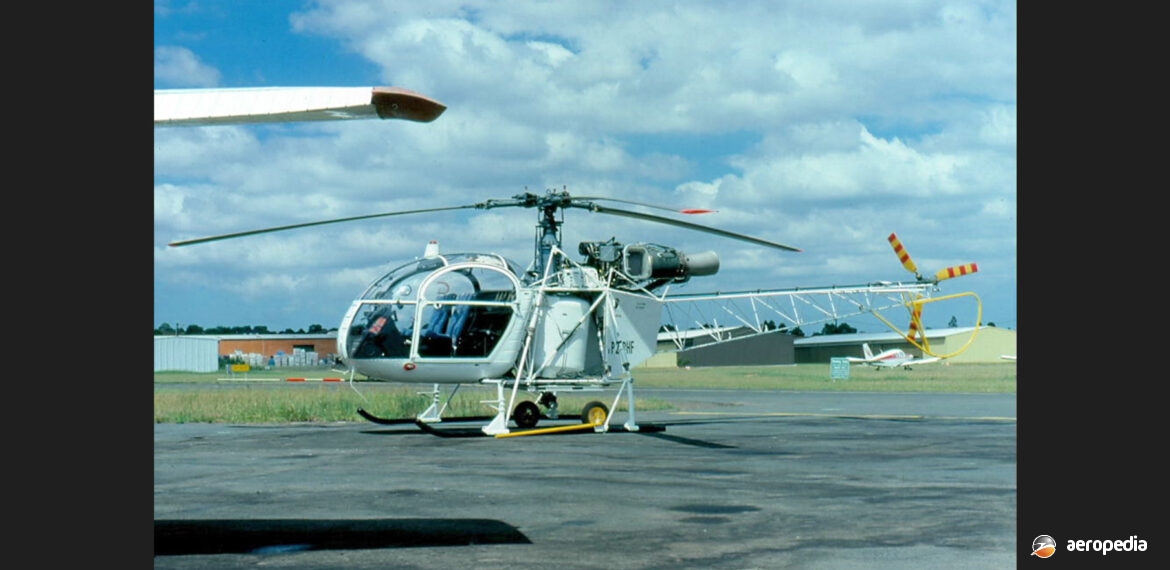Photograph:
Aerospatial SA-315 Lama P2-PHF (c/n 2650) at Bankstown, NSW (David C Eyre)
Country of origin:
France
Description:
Light utility helicopter
Power Plant:
One 649-kw (870-shp) Turbomeca Artouste IIIB turboshaft de-rated to 410-kw (550 shp)
Specifications:
- Rotor diameter: 11.02 m (35 ft 1 ¾ in)
- Fuselage length: 10.26 m (33 ft 8 in)
- Max speed at sea leve: 210 km/h (130 mph)
- Max cruising speed: 192 km/h (119 mph)
- Cruising speed with slung load: 120 km/h (75 mph)
- Max inclined rate of climb: 402 m/min (1,319 ft/min)
- Hovering ceiling in ground effect: 2,600 m (8,530 ft)
- Range at sea level at 1,750 kg (3,858 lb): 510 km (317 miles)
- Range at 3,000 m (9,840 ft): 600 km (373 miles)
- Empty weight: 995 kg (2,193 lb)
- Loaded: 2,200 kg (4,850 lb)
History:
The Lama was developed by Aerospatiale in France mainly to meet the requirements of the Indian armed forces for a light utility helicopter. Following approval by the Indian Government, licence production of the Lama commenced with the Indian aircraft manufacturer, Hindustan Aeronautics, and the type became known as the Cheetah. The Lama was developed from the SA-318C Alouette II and combined the airframe of this machine (with necessary strengthening to deal with the increased engine power) with the dynamic components of the SA-319A Alouette III.
The prototype was flown for the first time on 17 March 1969. Fitted with the Artouste IIIB turboshaft engine, which was de-rated from 649-kw (870-shp) to 410-kw (550-shp) to permit its maximum power to be available at altitude and in hot climates. The Lama could carry 1,000 kg (2,204 lb) externally at an altitude of 2,500 m (8,200 ft).
A small number of Lamas have been registered in this region. One VH-FJS (c/n 2029A – ex F-WKQF), which later became VH-PDU with Pacific Aviation, was used in the Mount Kosciusko National Park and in other mountain areas for the installation of ski-lifts and other associated equipment. This machine was first registered in June 1973 and spent sometime in New Guinea as P2-PDU before being exported in 1989. VH-BQT (c/n 2378) was first registered in December 1981, later in 1984 going to New Guinea as P2-BQT. It was destroyed in an accident in Malaysia in 1986. VH-TUR (c/n 2655 – ex JA9754, N58041) operated with Heliquip of Bowral, NSW.
Operators in New Zealand have included Helicopters (NZ) Ltd, Marine Helicopters, Farm Helicopters at Ardmore airfield, Papakura, and Helicopter Management Ltd. These machines were used in a variety of roles, including lifting of heavy equipment, aerial spraying, and top-dressing lime and superphosphate. Machines registered include; ZK-HKG (c/n 2480 – ex N47310) which crashed at Kaeo in December 1982; ZK-HNV (c/n 2508) exported to Switzerland in July 1984; ZK-HNW (c/n 2527) exported to Switzerland as HB-XMC in August 1984; ZK-HSK (c/n 2586); and ZK-HDX (c/n 2226) exported to the United Kingdom as G-BLLX in August 1984, later becoming F-GFCM.
The type has also been used extensively by Pacific Helicopters in New Guinea, and examples registered include P2-PDU (noted above), P2-PHE (c/n 2640), P2-PHF (c/n 2650) and P2-BQT (c/n 2378 – ex VH-BQT, N3763V, SE-HES).

